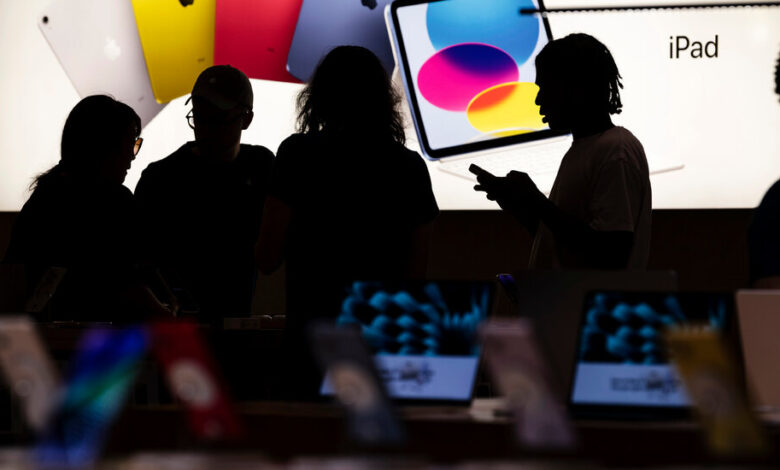Apple’s New iPad Ad Leaves Its Creative Audience Feeling … Flat

The trumpet is the first thing to be squished. Then the industrial compressor flattens a row of paint cans, buckles a piano and levels what appears to be a marble bust. In a final act of destruction, it pops the eyes out of a ball-shaped yellow emoji.
When the compressor rises, it reveals Apple’s latest commodity: the updated iPad Pro.
Tim Cook, Apple’s chief executive, posted the advertisement, called “Crush,” on Tuesday after the company held an event to announce new tablets. “Meet the new iPad Pro: the thinnest product we’ve ever created,” Mr. Cook wrote, adding, “Just imagine all the things it’ll be used to create.”
For decades, Apple has been the toast of the creative class. It has won over designers, musicians and film editors with promises that its products would help them “Think Different.”
But some creators took a different message from the one-minute iPad ad. Rather than seeing a device that could help them create, as Mr. Cook suggested, they saw a metaphor for how Big Tech has cashed in on their work by crushing or co-opting the artistic tools that humanity has used for centuries.
The image was especially unnerving at a time when artists fear that generative artificial intelligence, which can write poetry and create movies, might take away their jobs.
“It’s unusual in its cruelty,” said Justin Ouellette, a software designer in Portland, Ore., who does animation work and is a longtime Apple product user. “A lot of people see this as a betrayal of its commitment to human creative expression and a tone deafness to the pressures those artists feel at this time.”
Apple didn’t respond to requests for comment.
It was the latest in a series of recent promotional slip-ups by a company that is widely considered to be a marketing juggernaut. Its marketing of the Apple Vision Pro, released in January, struggled to help that device break through with many customers. Last year, Apple was criticized for making an awkward sketch that cast Octavia Spencer as Mother Earth, lording over a corporate meeting about the company’s effort to become carbon neutral by 2030.
Apple has been regarded as an advertising visionary since the 1980s. Its “1984” Super Bowl commercial to introduce the Macintosh computer is among the most famous commercials ever made. The ad, which was developed by the Chiat/Day agency, showed an actor throwing a sledgehammer through a screen projecting the face of a “Big Brother” figure that was meant to be a metaphor for IBM.
When Steve Jobs returned to Apple in 1997 after 12 years away, he sought to reclaim its marketing magic. Together he and Lee Clow, the advertising creative behind the “1984” spot, developed the “Think Different” campaign. It paved the way to the famous “Get a Mac” spots, featuring a Mac and PC, and the original iPhone ad, which showed people in classic films and television shows picking up a phone and saying, “Hello.”
Apple’s marketing pitched its products as easy to use. It billed PCs and Android phones as devices for business executives working on spreadsheets, while Macs and iPhones were tools for film editors, photographers and writers.
But Apple’s advertising has been uneven over the last dozen years or so. It yanked a 2012 campaign that showcased its Apple Store “geniuses” on planes. Critics dismissed a subsequent spot, “Designed by Apple in California,” as “lame.”
In the wake of those hiccups, Mr. Cook shifted oversight of advertising from Phil Schiller, the company’s longtime head of marketing, to Tor Myhren, a former president and chief creative officer at Grey, the ad agency that created the E-Trade baby.
Under Mr. Myhren, who joined in 2016, Apple has developed some of its ads with its own creative team and others in collaboration with an outside agency, Media Arts Lab. It has been recognized at the Cannes Lions Awards, the leading event for the ad industry, for a spot on AirPods called “Bounce,” which showed a man bounding off the sidewalk as he listened to music. Last year, Apple was named Creative Brand of the Year because of its “R.I.P. Leon” ad, in which a man sent an iPhone message saying a lizard in his care had died, then deleted it when the lizard suddenly rolled over off its back.
Mr. Myhren and Media Arts Lab didn’t respond to requests for comment about who was behind the “Crush” spot.
Michael J. Miraflor, the chief brand officer at Hannah Grey, a venture capital firm, said on X that Apple’s ad had effectively offended and turned off its core customer base, achieving the opposite of what it had done with its “1984” commercial.
“It’s not even that it’s boring or banal,” Mr. Miraflor wrote. “It makes me feel … bad? Bummed out?”



